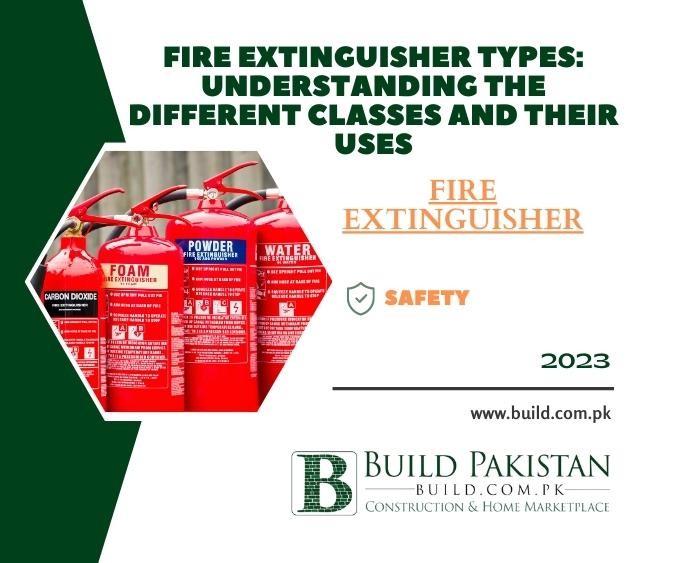Fire Extinguisher Types: Understanding the Different Classes and Their Uses

Introduction:
Fire safety is a critical aspect of maintaining
a safe environment, whether it's at home, in the workplace, or in public
spaces. Fire extinguishers are essential tools that can help control and
extinguish fires before they spread and cause significant damage. However, not
all fires are the same, and different types of fires require specific fire
extinguisher types for effective suppression. In this blog post, we will
explore the various classes of fire extinguishers and their uses, providing
valuable information to help you choose the right extinguisher for different
fire situations.
Class A Fire Extinguishers
Class A fire extinguishers are
designed to suppress fires involving ordinary combustible materials such as wood,
paper, cloth, rubber, and certain plastics. They are commonly found in homes,
offices, and schools. Key characteristics of Class A fire extinguishers
include:
Extinguishing Agent:
Class A fire extinguishers typically use
water or a water-based solution as the extinguishing agent. Some may also
contain foam additives to enhance the fire-suppression capabilities.
Use and Limitations:
Class A fire extinguishers are effective
for fires involving solid materials. They should not be used on fires involving
flammable liquids, electrical equipment, or cooking oil fires, as water can
spread these types of fires or cause electrical shock.
Class B Fire Extinguishers
Class B fire extinguishers are
specifically designed for fires involving flammable liquids and gases such as
gasoline, oil, paints, solvents, and propane. These fires often occur in
industrial settings, garages, kitchens, and areas where flammable substances
are stored. Key features of Class B fire extinguishers include:
Extinguishing Agent:
Class B fire extinguishers utilize dry
chemical agents, such as carbon dioxide (CO2), foam, or dry powder, to suppress
fires involving flammabe liquids and gases.
Use and Limitations:
Class B fire extinguishers are effective
in controlling and extinguishing fires caused by flammable liquids and gases.
They should not be used on fires involving electrical equipment, as the
discharge of dry chemical agents may cause damage or electrical shock.
Class C Fire Extinguishers
Class C fire extinguishers are
designed for fires involving energized electrical equiment. These fires can
occur in areas with electrical appliances, wiring, or electrical panels. It's
important to note that when dealing with electrical fires, the power source
should be shut off before using a fire extinguisher. Key characteristics of
Class C fire extinguishers include:
Extinguishing Agent:
Class C fire extinguishers typically
contain non-conductive agents, such as carbon dioxide (CO2) or dry chemical
powders, that do not conduct electricity.
Use and Limitations:
Class C fire extinguishers are
specifically designed to suppress fires involving energized electrical
equipment. They should not be used on fires involving flammable liquids or
solid materials.
Class D Fire Extinguishers
Class D fire extinguishers are
specifically designed for fires involving combustible metals, such as
magnesium, titanium, potassium, sodium, and aluminum. These fires are typically
found in laboratories, industrial settings, or places where these metals are
stored or used. Key features of Class D fire extinguishers include:
Extinguishing Agent:
Class D fire extinguishers use dry
powder agents, such as sodium chloride or graphite-based powders, to suppress
fires involving combustible metals.
Use and Limitations:
Class D fire extinguishers are intended
for fires involving specific combustible metals. They should not be used on
fires involving other materials such as flammable liquids, gases, or electrical
equipment.
Class K Fire Extinguishers
Class K fire extinguishers are
designed for fires involving cooking oils, fats, and grease, typically found in
commercial kitchens and restaurants. These fires can be particularly
challenging to extinguish due to the high temperatures and potential
re-ignition. Key characteristics of Class K fire extinguishers include:
Extinguishing Agent:
Class K fire extinguishers utilize
special wet chemical agents specifically formulated to suppress and cool down
cooking oil and grease fires.
Use and Limitations:
Class K fire extinguishers are suitable
for fires involving cooking oils, fats, and grease in commercial kitchens. They
are not designed for use on other types of fires.
Conclusion:
Choosing the right fire extinguisher type is
crucial for effective fire suppression. Understanding the different classes of
fire extinguishers and their uses is essential to ensure that you have the
appropriate extinguisher available in case of an emergency. Remember, it is
vital to follow the manufacturer's instructions, regularly inspect and maintain
fire extinguishers, and seek professional training in fire safety practices. By
being prepared and equipped with the proper fire extinguisherwe can enhance
our ability to respond effectively to fires and protect lives and property.









